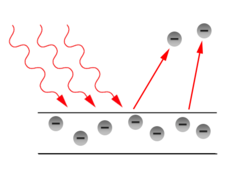With the non-renewable sources of nature diminishing and the global warming effect increasing, Solar energy is vital in the present times because the power demand in the world is a never-ending process. And the emergence of solar cells in the 19th century has signified the importance of solar energy today, in our lives.
A solar cell is a device converting sunlight energy directly into electricity using the photovoltaic effect. The term “photovoltaic” is used since 1849, derived from Greek ‘phos’ meaning “light” and ‘voltaic’ meaning “electric” from the name of the Italian physicist Volta. Today, these solar cells or the photovoltaic cells are used to make solar panels, solar modules, or photovoltaic arrays.
History
The photovoltaic effect was recognized first by French physicist A. E. Becquerel in 1839, but in 1883, Charles Fritts actually built the first solar cell (selenium-based). Later, Aleksandr Stoletov, the Russian physicist, made the first solar cell based on the outer photoelectric effect. Albert Einstein explained the photoelectric effect in 1905, for which he was awarded the Nobel Physics Prize in 1921.
In 1954, the solar power technology fully arrived in Bell Laboratories, where Daryl Chapin with his colleagues invented the first practical device for converting sunlight into electrical power when they were experimenting with semiconductors and accidentally realized that silicon doped with certain impurities was actually very sensitive to light. This finally resulted in producing the first proper solar cell with an efficiency for sunlight energy conversion of about 6%. Thus, reproduction and evolution with a chain culminating into different types of solar cells continue till today.
Present
Though selenium gave way to silicon, which dominated solar cell production in the 20th century and still does, today we have several other solar cells gaining momentum like cadmium telluride, amorphous silicon CIGS, among others. These semiconductors have become very famous of late to create several different kinds of solar cell like plastic or polymer, dye-sensitized, organic or monocrystalline silicon, copper-indium selenide, nanocrystalline solar cells, and others.
Currently, there is interest from the largest countries in the world, meaning solar efficiencies could improve rapidly
The challenge of increasing photovoltaic efficiency is of great interest as much of the solar industry is focused on the most cost-efficient technologies in terms of the cost per generated power. This, with the recent breakthroughs in solar energy, has made the use of solar cells more competitive these days. For instance, in recent research, scientists have verified experimentally that the hot electrons could double the solar cell power efficiency without cooling it down; or the Nanotechnology that uses nanomaterial composites to enhance overall solar cell efficiency is another major step in this field.
Future
This power source for all communications and scientific satellites is expanding rapidly with more scope in the future. It is fast becoming a key element of the renewable energy effort to reduce fossil fuels’ use to combat the already emerging global warming. Since the global electricity requirements are expected to double in the next 40 years, more and more cars will also be fuelled by electric power, apart from solar cells in homes, businesses, or other applications. This has also highlighted the importance of the Laser technology that can optimize the manufacturing costs and efficiency of solar cells. With technological advancements and expanding applications, solar cell costs are expected to fall in the future, making an easy-buy for average customers.








I don’t think it was the Nobel Peace Prize that Einstein got in 1921, but the physics prize. I mean he was a man of peace and all, but…
Mafa, you’re right. That was The Nobel Prize in Physics 1921. Thank you for pointing that out.
check out out new Solar film which goes over solar panels. Hypersolar